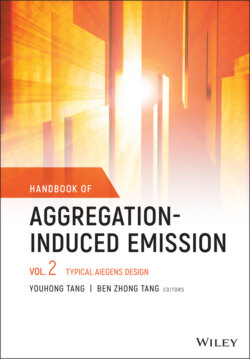Читать книгу Handbook of Aggregation-Induced Emission, Volume 2 - Группа авторов - Страница 21
1.3.4 Metal–organic Framework
ОглавлениеMOFs are a kind of organic–inorganic crystals that consist of metal ions and organic molecules as center and ligand, respectively. The two‐ or three‐dimensional rigid framework makes them porous with a large specific surface area and tunable pore size, thus very promising for utilization as porous materials [58]. MOFs can also be developed as luminescent materials because of their potential luminescent properties of metal ions and ligands. Recently, some luminescent MOFs with TPE‐based units as ligand have been designed to exhibit sensing and photocatalytic behaviors [59, 60]. As TPP shows the similar structural symmetry to TPE, TPP‐based MOFs are thus desired to be developed.
Yin developed MOFs with Ln3+ ions, including Eu3+, Tb3+, and Gd3+ as centers and tetracarboxyl‐substituted TPP (TPP‐4COOH) as ligand [61]. The coordination process can proceed in the mixed solution and be monitored by turn‐on emission, indicative of a coordination‐induced emission. However, different ion centers may cause different optical properties of MOFs (Figure 1.4a). Eu3+‐MOF possesses obvious dual emissions at around 420 and 630 nm, which are originated from the TPP unit and Eu3+, while only the emission of TPP can be observed in Gd3+‐MOF. The emission of Tb3+ in Tb3+‐MOF in the long‐wavelength region is weak but still can be discerned. This is due to the different energy gaps between the singlet state and triplet state of a ligand and the triplet state of a ligand and the excited state of metal ions, which determines the different intersystem crossing and sensitization efficiencies (Figure 1.4a). In other words, the emission of metal ions is influenced by the combined consideration of the orbital properties of both metal centers and organic ligands.
Although the various metal ions have been employed, their MOFs show similar structural morphologies as revealed by PXRD analysis, indicative of the university of choosing TPP to design MOFs. Moreover, the emission of the TPP unit in MOFs is somewhat blue‐shifted than those of TPP‐4COOH. As the formation of MOF can be regarded as a crystallization process, TPP must adjust the conformation to fit the crystal lattice, while a much twisted molecular structure will shorten the conjugation to blue‐shift the emission, which is in accordance with the results obtained by the single‐crystal diffraction analysis (Figure 1.4b). On the other hand, the ΦF of TPP‐4COOH was measured to be 12.9% in the solid state. However, after being introduced into MOF, the Eu3+‐MOF shows dual emissions with a remarkably increased ΦF of 60.8%. It demonstrates a useful strategy to construct highly efficient luminescent materials by utilizing coordination‐induced emission and antenna effect.
Figure 1.4 Functional MOFs with TPP‐4COOH as ligand for sensing. (a) Intersystem crossing and sensitization effect determined by the energy level properties of ligands and metal ions. (b) Crystal structure of Eu3+‐MOF. (c) PL spectra of Eu3+‐MOF upon the addition of arginine with different concentrations. (d) Model of hydrogen formation between MOF and arginine.
As two fluorescent channels are observed in the Eu3+‐MOF, it is potential to develop a ratiometric fluorescent probe based on it. Interestingly, Eu3+‐MOF has a fluorescent response to arginine, which is an essential amino acid in the body associated with a variety of diseases like cardiovascular and cerebrovascular diseases and hyperammonemia, etc [61]. Upon the addition of arginine, the emission of the TPP unit enhances gradually, while those of Eu3+ changes less, thus making the signals ratiometrically detectable (Figure 1.4c). It is due to the nitrogen atoms in the central pyrazine ring of the TPP unit, which provides sites for binding. On the other hand, the pores in the MOFs are competent in accommodating the arginine. The arginine, therefore, can enter into the MOF and form a hydrogen bond with TPP, thus offering an additional steric hindrance to restrict molecular motions to enhance emission (Figure 1.4d). The emission behavior of Eu3+ is less influenced because no interaction is found between Eu3+ and arginine. Besides, by replacing the TPP‐4COOH ligand with tetracarboxyl‐substituted tetraphenylbenzene, the resulting MOF does not possess a response to arginine, further proving the importance of the introduction of an AIE‐active TPP unit. The sensor also shows a good selectivity against other amino acids and high sensitivity with a detection limit as low as 15 nM.
